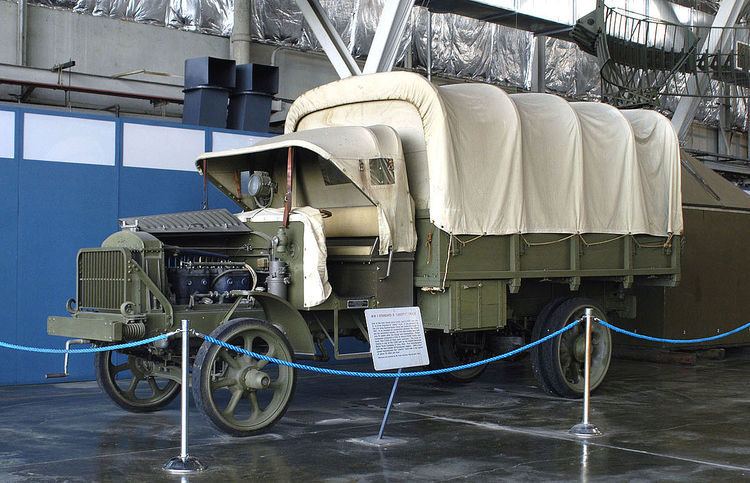The Standard B "Liberty" Truck was a United States Army vehicle used in World War I.
The Liberty Truck was designed by the Motor Transport section of the Quartermaster Corps in cooperation with the members of the Society of Automotive Engineers. Production of the 3–5 ton truck began in 1917, and the first models appeared ten weeks after the design was standardized. Of the almost 9,500 produced by 15 manufacturers, more than 7,500 were sent overseas. The Liberty's four-speed transmission coupled with its 52-hp engine gave the truck a top speed of about 15 miles per hour (24 km/h).
Series IBattery, generator and distributor with electrical lighting system, in addition to the independent magneto ignitionDistributor and magneto systems with independent sparkplugs and wires (two per cylinder)Ball and coil spring device to hold starter crank up in frontPrimarily wooden spoke wheels vs. more robust steel wheels but Steel wheels were issued on 1st variant in later production (reference photo of Indiana manufacturing plant storage lot)Single clamp hold-down radiator cap threaded in the center into the radiatorElectric side lightsElectric Guide lights up front on the frame horn members inside wheel areaElectric tail lampElectrical troubleshooting lamp plug in dashDual ignition switch on dash for battery or magneto ignitionAmmeter in dash switch cluster (lights/battery/mag, the gauge and a plug socket for a trouble light)Single dash-mounted fuel tank which gravity fed the carburetorSeries IIMagneto only, (distributor, battery, generator and electrical light systems removed)Pressed steel spring clip to hold starting crank, vs. ball under spring clampAcetylene Gas illuminated spot/driving light in the center of the dashboardAcetylene Gas illuminated side lights (possible transition from electric as they dropped the battery system)Oil wick rear taillampSpring-mounted oil fill caps raised to vertical level for easier filling on suspensionOil filler for engine moved to rear of blockRadiator uses flip-type cap with hinge to rear and lock bolts on the sidesSecond fuel tank under passenger seatFuel tank hand pump on extreme right of cab for transferring fuel from the undersea mounted rear tank to primary dash mounted tank (co-driver job)The Standard B "Liberty" Truck's powertrain utilized a gasoline powered 425 cubic-inch flat-head inline four cylinder that put out 52 horsepower, a 4 speed transmission, and a 4 X 2 drive setup.
There is one at the Fort Bliss museum,One at the Fort Eustis, U.S. Army Transportation MuseumOne at the National Museum of the United States Air Force Dayton, OhioOne at the First Division MuseumOne with Virginia Military Preservation Association [1] (W. Winget owner) in VirginiaOne at the National Infantry Museum [2], Columbus, GeorgiaOne at the Oregon Military Museum.One at the Iowa Military museum. [3]One at the Allen County Museum, Lima, Ohio. [4]One at the Camp Creek showgrounds near Waverly, NebraskaOne at the National Marine Corps Museum at Quantico. Triangle, VirginiaOne at the Texas Military Forces Museum at Camp Mabry Austin, TexasTwo at the LeMay Family Collection Foundation Spanaway, Washington. [5]
